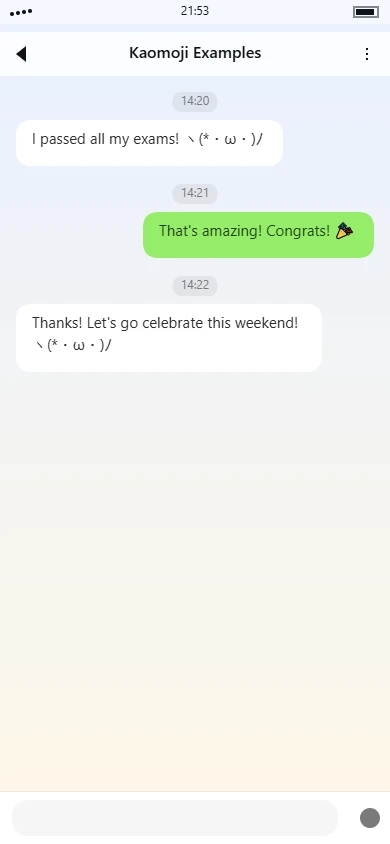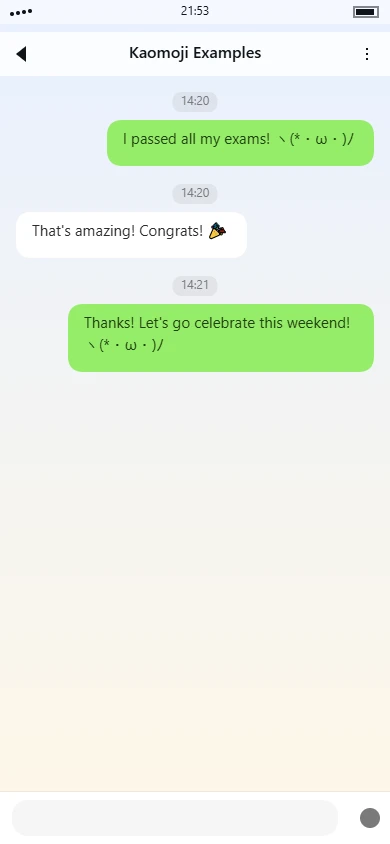(´。• ᵕ •。`) kaomoji meaning | usage tips

Overview
This kaomoji (´。• ᵕ •。`) presents a gentle, affectionate facial expression through carefully arranged Unicode characters. The overall structure creates a soft, rounded face shape with distinctive eye and mouth elements that convey a sense of tender emotion.
Visual Structure Explanation
The kaomoji uses curved parentheses
()´••`ᵕ。Symbol Breakdown
- Parentheses
(
: Serve as the face outline, creating a soft, rounded container for the facial features) - Acute and grave accents
´
: Function as the outer parts of the eyes, suggesting a slightly downward or gentle gaze` - Middle dots
: Positioned as the main eye elements, providing simple circular shapes for pupils or irises• - Small ideographic full stop
: Used as decorative elements beside the eyes, possibly representing blush marks or additional facial details。 - Modifier letter small turned h
: Forms the mouth with a curved shape that suggests a small, content smileᵕ - Spacing: The careful spacing between elements creates a balanced, symmetrical composition
Emotion & Aesthetic Analysis
The emotional tone conveyed by this kaomoji is one of gentle affection and contentment. The downward-curving eyes combined with the small smile create an expression that reads as tender, slightly shy, or fond. The rounded face shape and symmetrical composition contribute to a sense of harmony and softness.
Compared to more exaggerated happy kaomoji like (^▽^) or (^_^), this expression is more subdued and intimate. The emotion is not overtly excited or energetic, but rather conveys a quiet, personal happiness. The decorative dots add a touch of cuteness without overwhelming the overall composition, maintaining a balanced aesthetic that feels both structured and organic.
In practical usage, this kaomoji might appear in contexts where someone wants to express gentle approval, affectionate agreement, or quiet contentment. It works well in situations that call for a softer emotional tone than more exuberant smiley faces, such as when sharing personal thoughts, expressing gratitude, or responding to sentimental content. The overall effect is one of understated warmth rather than overt excitement.
Tag categories
Use tags to quickly understand this kaomoji.
Emotion tags
Object tags
Click tags to explore related kaomoji.
Usage guide
Usage Guide for (´。• ᵕ •。`)
This gentle, sweet-faced kaomoji captures a delicate expression of contentment, affection, and tender happiness. With its soft eyes and small, curved mouth, it conveys a sense of warmth and sincerity that's perfect for sharing positive emotions in casual digital communication. You'll often see it used when someone wants to express heartfelt gratitude, share a moment of quiet joy, or respond to something genuinely touching or adorable. The kaomoji's balanced features give it a calm, non-exaggerated quality—making it suitable for situations where you want to show appreciation without being overly dramatic or playful.
Use Cases
- Thanking a friend for their thoughtful advice or support
- Reacting to a cute pet photo or baby picture shared in a group chat
- Expressing quiet happiness after receiving a small, personal compliment
- Responding to a heartfelt message from a close friend or family member
- Showing appreciation for a coworker's help on a collaborative project
- Commenting on a comforting piece of music or artwork online
- Sharing your contentment about a peaceful moment in your day
- Reacting to someone's personal achievement or good news
- Expressing gentle amusement at a clever but not hilarious joke
- Showing understanding and warmth during an emotional conversation
- Responding to nostalgic memories shared in a friendly discussion
- Acknowledging a kind gesture that made your day better
Examples
-
Friend: I saved you a slice of cake from the party!
You: aw thank you so much (´。• ᵕ •。`) that's really sweet of you -
You: Just finished reading that book you recommended
Friend: What did you think?
You: It was beautiful, honestly (´。• ᵕ •。`) the ending made me tear up a little -
Family member: Remember that summer we spent at grandma's? I found these old photos
You: oh wow (´。• ᵕ •。`) those bring back so many good memories -
Colleague: I noticed you were swamped so I handled those emails for you
You: You're amazing, thank you (´。• ᵕ •。`) I really appreciate that -
Online friend: Your artwork always makes my day brighter
You: that means so much coming from you (´。• ᵕ •。`) thank you for saying that -
You: The sunset tonight is absolutely stunning
Friend: Just looked outside—you're right!
You: right? (´。• ᵕ •。`) it's the perfect end to the day
Notes
- Avoid using this kaomoji in formal business communications, professional emails, or serious discussions where a more straightforward response is expected. Its gentle, emotional tone might come across as unprofessional or too casual for formal contexts.
- While this expression conveys sincerity, be mindful that in some text-based conversations without additional context, it might be misinterpreted as passive-aggressive or sarcastic—especially if the conversation has been tense. When in doubt, pair it with clear, positive wording.
- This kaomoji works particularly well on platforms like Discord, Twitter, and personal messaging apps where casual, emotional expression is common. On more professional platforms like LinkedIn or formal work channels, it's better to stick with standard emoji or plain text to maintain appropriate tone.
Usage examples
Real conversation samples that feature this kaomoji.

Example 1

Example 2
Related kaomoji
You might also enjoy these kaomoji.